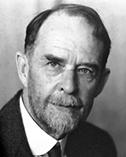
 Thomas Hunt Morgan
Thomas Hunt Morgan
1927-1931 NAS President
When Michelson retired from the presidency of the Academy in 1927, the brilliant geneticist Thomas Hunt Morgan (1866–1945) seemed to be a very reasonable candidate to replace him. He was broadly based in the biological sciences and had gained fame through a study of the genetic properties of the fruit fly with great emphasis on the details linking phenotype to the variance in chromosomal structure.
Morgan had completed his undergraduate work at the University of Kentucky in natural history in 1886 and obtained a Ph.D. at Johns Hopkins University in 1890. He received a research and teaching position at Bryn Mawr College in 1891 but then moved on to Columbia University in 1904 where he remained until 1928. In the intervening period, he spent a great deal of time at Woods Hole during the summers working very broadly in the biological world. However, he became more and more specialized on research dealing with the chromosomes of the fruit fly, rediscovering as it were an inner cell hereditary link that coupled closely with Gregor Mendel's earlier discoveries in plant genetics. The work on fruit flies apparently began in the period 1908–1909.
Along the way, he spent a good deal of time at the zoological station in Naples. The atmosphere there was international and provided Morgan with excellent opportunities to become familiar with many European biologists. His professional life became very rich.
The selection of Morgan as president of the Academy seemed in keeping with what might be called unwritten rules requiring that the president be in relatively close proximity to Washington. By 1927 Washington was only a four or five hour train trip away from New York. The California Institute of Technology, however, made Morgan a very attractive offer to head the division of biological sciences there in 1928 when he was sixty-two years old. After some hesitation he accepted the offer and with it inevitably changed his lifestyle. Air travel was essentially unknown at that time and, for the most part, the truly rapid so-called streamlined trains lay somewhat in the future. As a result Morgan could only maintain modest personal communication with the Academy, mainly by telephone and through intermediates. His remaining years in office were not highly distinguished by much in the way of novel activity.
The Great Depression
To cap it all, the Great Depression struck the country in the autumn of 1929 and was not to lose its grip until the onset of World War II ten years later. The request for services from the National Research Council had actually dropped off rapidly once World War I war ended and the budgets of the federal agencies more or less resumed peacetime levels. The depression, however, exacerbated severely what was already a difficult situation. It was also aggravated by the fact that the charter of the Academy seemed to imply to some that it could only respond to requests and should not help in generating them unless asked, as was the case for President Marsh.
Continue reading next chapter: William Wallace Campbell

